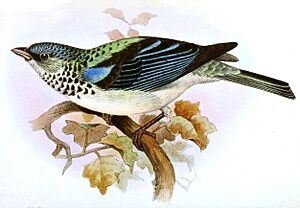Azure-rumped tanager facts for kids
Quick facts for kids Azure-rumped tanager |
|
|---|---|
 |
|
| Conservation status | |
| Scientific classification | |
| Genus: |
Poecilostreptus
|
| Species: |
cabanisi
|
 |
|
| Synonyms | |
|
|
The azure-rumped tanager (also called Cabanis's tanager) is a beautiful bird from the Thraupidae family, which includes many types of tanagers. This bird lives in the humid forests and nearby farms on the Pacific side of western Guatemala and southern Chiapas, Mexico. You can find them living at heights between 850 and 1,900 meters (about 2,790 to 6,230 feet) above sea level.
About the Azure-rumped Tanager
This tanager has mostly pale blue feathers. Its head is a purplish-blue, and it has special dark spots across its chest. The area around its eyes and lower cheeks is dark. Its back feathers are a mix of greenish-blue and black. The wings and tail are black with blue edges. Its beak is gray with a dark tip.
Azure-rumped tanagers make several soft, whistling sounds. They also make a hard trill and chattering noises.
What They Eat and How They Live
The azure-rumped tanager eats both fruit and insects. This means they are omnivores. In Guatemala, more tanagers were found where there were many Ficus aurea trees. The figs from these trees are a very important food source for them.
The nesting season for these birds is from April to September. During this time, they often move around in pairs or small family groups. Sometimes, other birds help raise the young, which is called cooperative breeding. Outside of the nesting season, larger groups of up to 18 birds have been seen together.
Protecting the Azure-rumped Tanager
The azure-rumped tanager is considered a vulnerable species. This means it is at risk of becoming endangered. The main reason for this is deforestation, which is when forests are cut down. People clear these forests to make space for coffee plantations.
In Guatemala, only about 21% of the original broadleaf forest remains. This is the main home for the tanager. About 80,000 hectares (or 68%) of the area where they could live is now covered with coffee farms. Experts believe there are only about 8,250 to 23,250 of these birds left in Guatemala.
There isn't a recent count for Chiapas, Mexico. However, in the 1980s, there were 112,000 hectares of good habitat there. This area is likely much smaller now because more people live there and farming has increased.
The bird that looks most like the azure-rumped tanager is the grey-and-gold tanager. They have similar patterns on their feathers.


